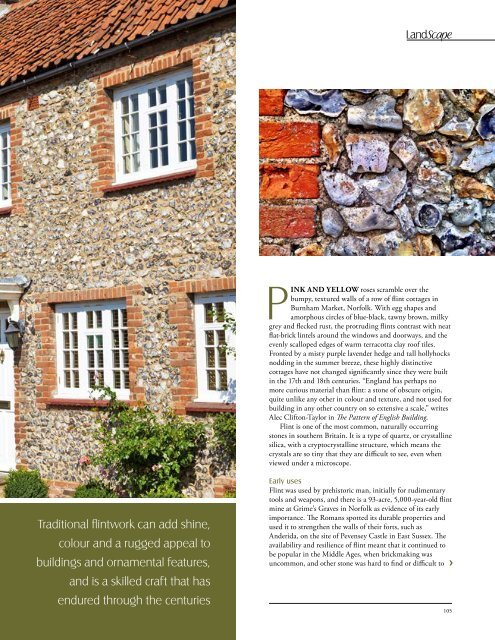You also want an ePaper? Increase the reach of your titles
YUMPU automatically turns print PDFs into web optimized ePapers that Google loves.
PINK AND YELLOW roses scramble over the<br />
bumpy, textured walls of a row of flint cottages in<br />
Burnham Market, Norfolk. With egg shapes and<br />
amorphous circles of blue-black, tawny brown, milky<br />
grey and flecked rust, the protruding flints contrast with neat<br />
flat-brick lintels around the windows and doorways, and the<br />
evenly scalloped edges of warm terracotta clay roof tiles.<br />
Fronted by a misty purple lavender hedge and tall hollyhocks<br />
nodding in the summer breeze, these highly distinctive<br />
cottages have not changed significantly since they were built<br />
in the 17th and 18th centuries. “England has perhaps no<br />
more curious material than flint: a stone of obscure origin,<br />
quite unlike any other in colour and texture, and not used for<br />
building in any other country on so extensive a scale,” writes<br />
Alec Clifton-Taylor in The Pattern of English Building.<br />
Flint is one of the most common, naturally occurring<br />
stones in southern Britain. It is a type of quartz, or crystalline<br />
silica, with a cryptocrystalline structure, which means the<br />
crystals are so tiny that they are difficult to see, even when<br />
viewed under a microscope.<br />
Traditional flintwork can add shine,<br />
colour and a rugged appeal to<br />
buildings and ornamental features,<br />
and is a skilled craft that has<br />
endured through the centuries<br />
Early uses<br />
Flint was used by prehistoric man, initially for rudimentary<br />
tools and weapons, and there is a 93-acre, 5,000-year-old flint<br />
mine at Grime’s Graves in Norfolk as evidence of its early<br />
importance. The Romans spotted its durable properties and<br />
used it to strengthen the walls of their forts, such as<br />
Anderida, on the site of Pevensey Castle in East Sussex. The<br />
availability and resilience of flint meant that it continued to<br />
be popular in the Middle Ages, when brickmaking was<br />
uncommon, and other stone was hard to find or difficult to ❯<br />
105
















